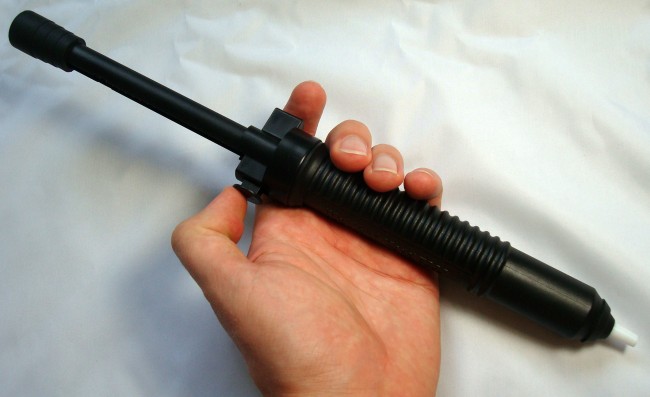well
Be careful! I cut the standoffs first, to get the regs out of the way. Then wick away as much solder as possible. Then one can remove the remaining posts one at a time-heating the post will also release it from the plastic (as the plastic softens), or one can gently pry the plastic up from the board, and cut the stand offs, and then remove one at a time. The plastic spacer will move on the posts with the application of a little heat.
Just do not use too much force, which could damage to board, work slowly and patiently.
Any tips on how to easily remove the old tridents? Thanks
Be careful! I cut the standoffs first, to get the regs out of the way. Then wick away as much solder as possible. Then one can remove the remaining posts one at a time-heating the post will also release it from the plastic (as the plastic softens), or one can gently pry the plastic up from the board, and cut the stand offs, and then remove one at a time. The plastic spacer will move on the posts with the application of a little heat.
Just do not use too much force, which could damage to board, work slowly and patiently.
If you have access to hot air rework station it is pretty easy to remove the tridents.
If I had, I wouldn't make the proposal. And I don't think the average DIY'er has.
If I had, I wouldn't make the proposal. And I don't think the average DIY'er has.
I understand, I am just saying that is the easiest and safest way to do it.
There is more simple solution. When you solder to dac board pin headers just solder to tridents female headers as well.
I was just going to say that.
If you fancy changing things up - headers are always the best choice.

I installed the new Tridents two weeks ago on my BII and there is improvement in all areas. Most noticable is more analogue, less digital warm sound and stronger more precise DEEP bass, more details from background, better 3d stereo imaging, and, and and ...
TP rulez
TP rulez
Last edited:
Removing the old trident from the Bii is pain in the back, I'm thinking of just changing the error amp. Russ, is it ok just replace the old error amp with new one? Any other component need to add or change?
1) They will still be quite different, but the Trident 1 will now have better bandwidth and be a bit more solid into extremely dynamic loads. It's very difficult to make such a comparison.
Removing the old trident from the Bii is pain in the back, I'm thinking of just changing the error amp. Russ, is it ok just replace the old error amp with new one? Any other component need to add or change?
Thanks.
Sorry, but I don't see the issue with removing the original Tridents. I simply melted the solder where the pins from the main board connected to the Trident (In, Ground and Out) and gently pulled the old Trident off the pins. Then I floated the new Tridents onto the same pins. Took five minutes (and that included heating up the iron)
Of course, the Clock reg was on a plug in header which made swapping rather easier!
Which reminds me of and old suggestion which I have never proposed.
Russ, you could make the boards a fraction more DIY friendly by increasing the diameter of the leaded-holes just a bit. When you have a tight fit and a 2 layer board the removal procedure is tricky . Both suction wick and tool are struggling reaching the solder and the risk of damaging the via is imminent.
I did it easy with a normal solder iron. Just heat all the legs at a time and you can pull it out. Heat the joints and slay the board in your left hand into a table. Carefull only your hand shall hit the table. For Gods sake not the board.
Last edited:
Ok those of you who asked for an updated AVCC module (like the trident) - you now have one. 
http://www.diyaudio.com/forums/twisted-pear/220750-avcc-module-update.html#post3185408
http://www.diyaudio.com/forums/twisted-pear/220750-avcc-module-update.html#post3185408
OK, so my new AVCC regulators were one of the most cost effective upgrades to date on my BII. I was wondering if others have changed both the AVCC and the Tridents, and could compare/contrast what they thought. I have a couple of extra sets of Tridents here, and wonder if it is going to be worth it considering I will essentially be throwing these away for lack of further need. Furthermore, I will not be using the VO as I am synchronously clocking.
A solder sucker comes in handy for desoldering. They range in price from a few bucks to hundreds, like the Hako 808.

An externally hosted image should be here but it was not working when we last tested it.
Last edited:
- Status
- This old topic is closed. If you want to reopen this topic, contact a moderator using the "Report Post" button.
- Home
- More Vendors...
- Twisted Pear
- Trident Evolves - Version 3
